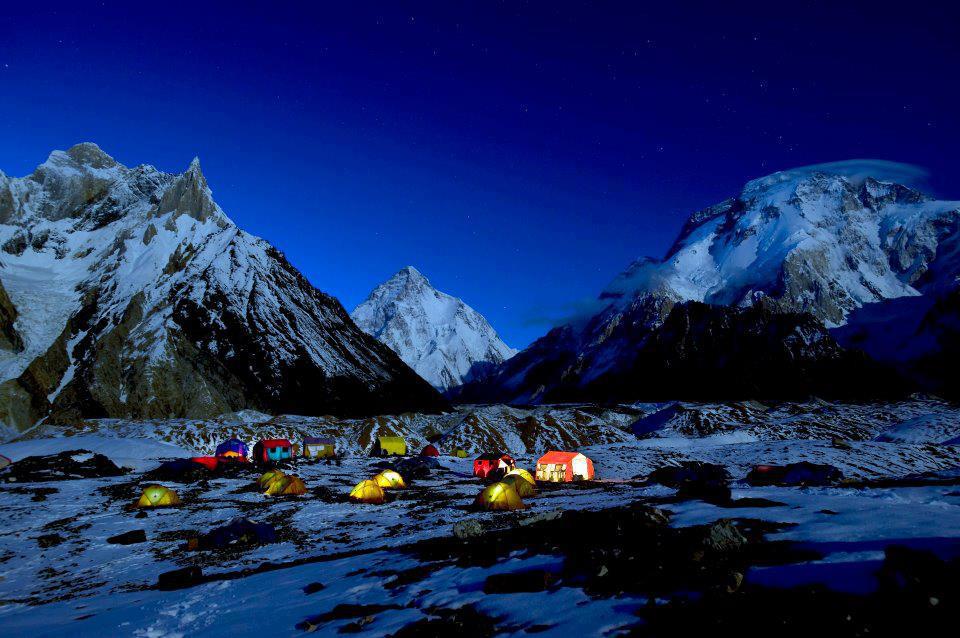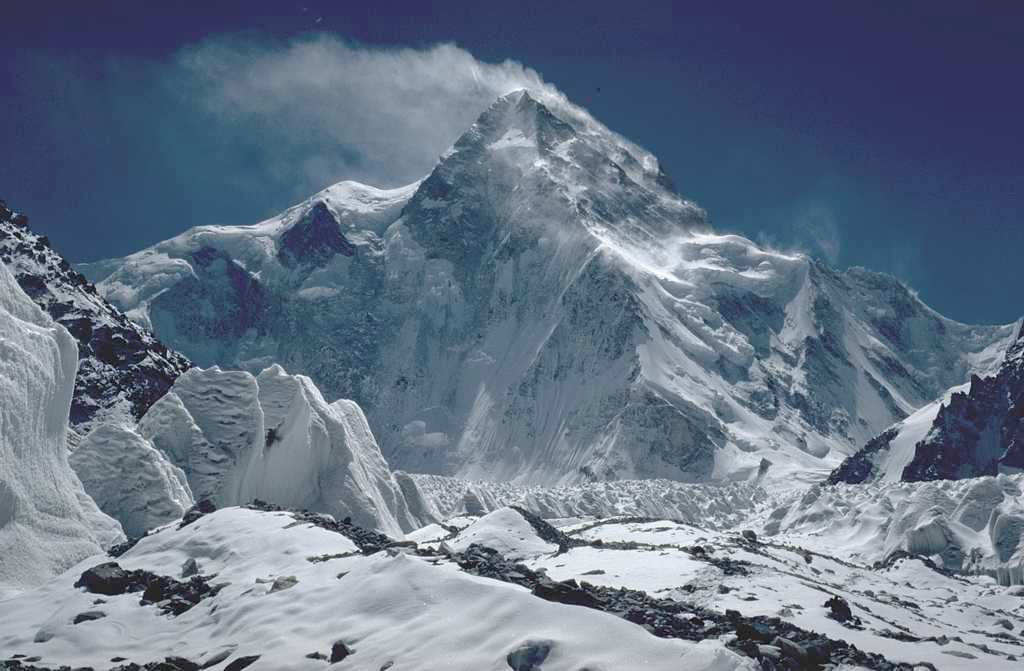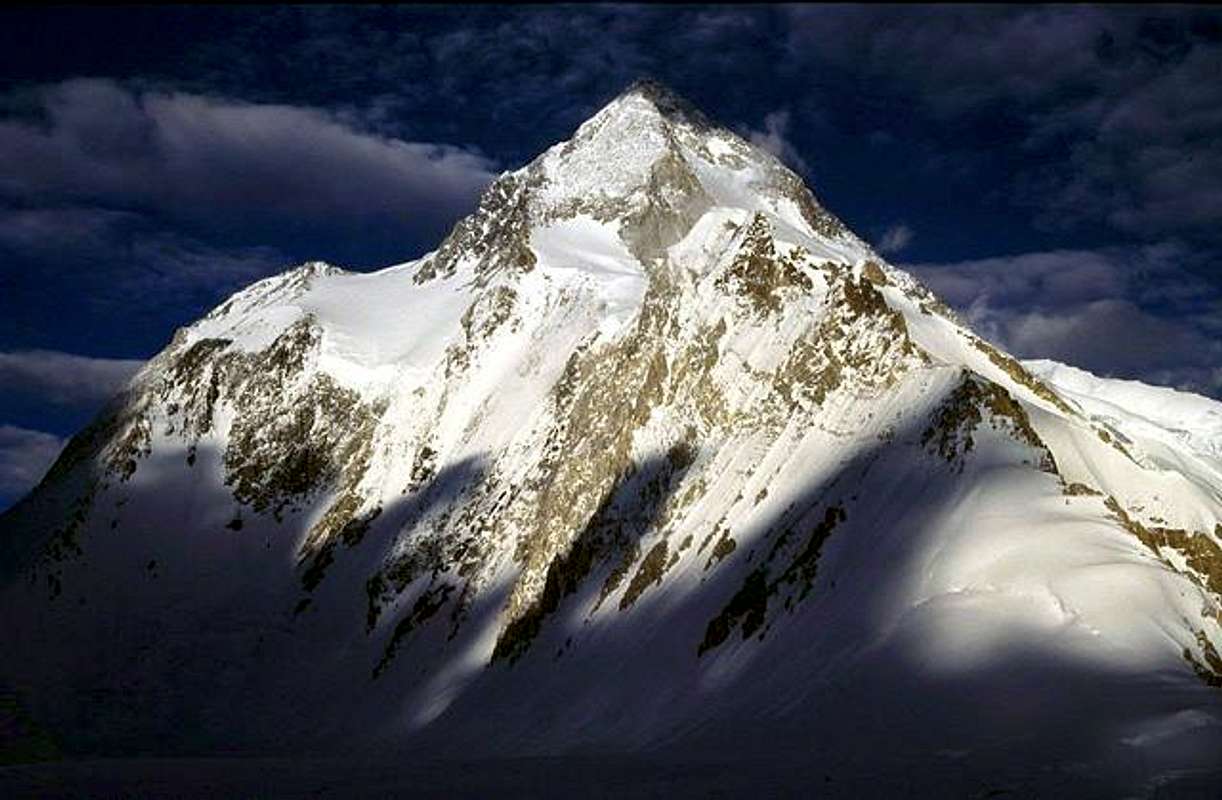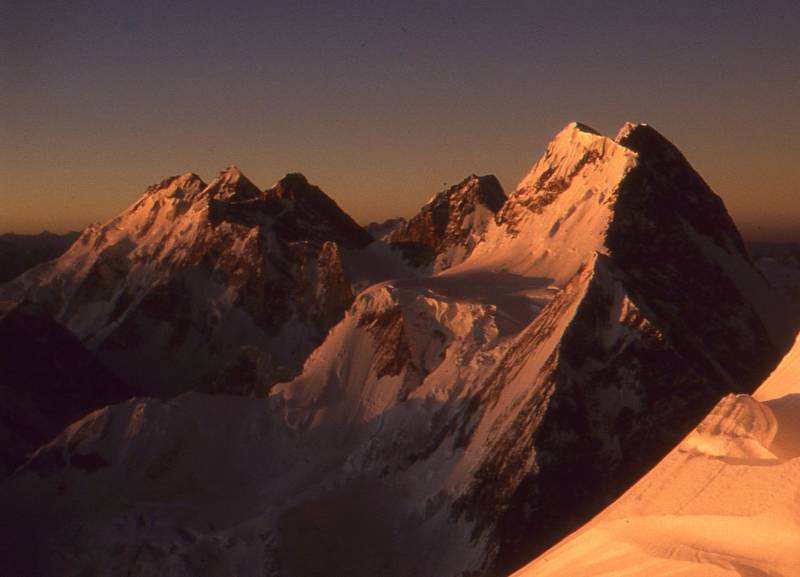It’s International Mountain Day today. Pakistan is home to 108 peaks above 7,000 metres and probably as many peaks above 6,000 m. There is no count of the peaks above 5,000 and 4,000 m. Five of the 14 highest independent peaks in the world (the eight-thousanders) are in Pakistan. Feast your eyes on pictures of world's highest peaks.
1. K-2
K2 has a singular place in high-altitude mountaineering. It is the second highest peak in the world. Though 784 feet lower than Mount Everest, it has long been known as the mountaineer’s mountain. The sharp triangle of its silhouette and height above the surrounding terrain not only define the archetypal image of a mountain but, as a practical matter, also make K2 far more difficult and dangerous to climb.

After the first attempts by British and Italian climbing teams in the early 1900s, American parties tackled K2 in 1938, 1939, and 1953. Charles Houston and Robert Bates titled their account of their 1953 expedition K2: The Savage Mountain. In 1954 K2 was finally “conquered” by a large Italian expedition that put two men on the top via the now standard summit route on the Pakistani side of the mountain.

One of the mountaineer David Roberts articulates his experience.
“The exhausted climber scanned the frozen slope above him as darkness began to engulf the mountain. “Lino! Achille! Where are you?” he cried. The only answer was silence. It was July 30, 1954. At the end of a marathon day of load-hauling, Walter Bonatti and his gritty companion, the Hunza porter Amir Mahdi, had reached an altitude of 26,575 feet on Pakistan’s K2, the world’s second highest mountain.”

2. Nanga Parbat:
Nanga Parbat is the 9th highest mountain in the world at 8,126 metres (26,660 ft) above sea level. An immense, dramatic peak rising far above its surrounding terrain, Nanga Parbat is also a notoriously difficult climb. Numerous mountaineering deaths in the mid and early 20th century lent it the nickname "killer mountain".

Here is an account of the polish climbers, Darek Załuski and Jacek Jawień by Mark Jenkins:
"Numbing cold, gale-force winds, avalanches, frostbite. Why risk your neck on Pakistan's Nanga Parbat in the middle of winter? Ask Polish climbers.
Nanga Parbat, the "naked mountain," is one of the most coveted prizes for Polish winter mountaineers. Four previous Polish teams have attempted it, and all have failed.
Separated from the rest of the Karakoram by the Indus River, Nanga Parbat is a lone pyramid at the western end of the Himalaya. It was the first 8,000-meter peak ever attempted, in 1895 by Englishman A. F. Mummery, and, as if to warn the world, the mountain summarily killed Mummery and his two high-altitude porters. Twenty-eight more people would die on four inglorious expeditions before Austrian Hermann Buhl reached the summit in 1953.
Polish mountaineers would have given anything, including probably their limbs and lives, to have competed for the first ascent of Nanga Parbat."

3. Gashurbrum I:
Gasherbrum I, also known as Hidden Peak or K5, is the 11th highest mountain in the world at 8,080 metres (26,510 ft) above sea level. It is located on the Pakistani–Chinese border in Gilgit–Baltistan region of Pakistan and Xinjiang region of China. Gasherbrum I is part of the Gasherbrum massif, located in the Karakoram region of the Himalaya. Gasherbrum is often claimed to mean "Shining Wall", presumably a reference to the highly visible face of the neighboring peak Gasherbrum IV; but in fact it comes from "rgasha" (beautiful) + "brum" (mountain) in Balti, hence it actually means "beautiful mountain."

Here is an enthralling account of Cory Richards and his expedition:
When Cory Richards set out to climb Gasherbrum II (also called K4) in early 2011 with Simone Moro of Italy and Denis Urubko of Kazakhstan, he didn’t initially realize he would be the first American to summit an 8,000-foot peak in winter. He just knew his team was aspiring to make the first winter ascent of Gasherbrum II. “It was life altering in a lot of ways,” says Richards. “I pushed myself harder as a climber and photographer than ever before.”
Located in Pakistan, in the Karakoram Range, Gasherbrum II is the 13th highest mountain in the world at 26,362 feet. The standard climbing route on the southwest ridge has hazards such as crevasses, avalanches, and rock fall—even in the summer. Winter conditions elevate it to a whole new level.
During his six weeks on the mountain, Richards experienced winds as high as 43 miles per hour and temperatures as low as minus 51ºF (not including windchill). On the descent, the team was nearly killed by an avalanche that partially buried them. “I felt like we were wearing the margin thinner and thinner,” Richards says. “And it is something that has fundamentally altered me—both positively and negatively.”

4. Broad Peak
Broad Peak is the 12th highest mountain in the world at 8,051 metres (26,414 ft) above sea level. The literal translation of "Broad Peak" to Falchan Kangri is not accepted among the Balti people. The English name was introduced in 1892 by the British explorer Martin Conway, in reference to the similarly named Breithorn in the Alps.

The first ascent of Broad Peak was made on June 9, 1957 by Fritz Wintersteller, Marcus Schmuck, Kurt Diemberger, and Hermann Buhl of an Austrian expedition led by Marcus Schmuck. A first attempt by the team was made on May 29 where Fritz Wintersteller and Kurt Diemberger reached the forepeak (8,030 m). This was also accomplished without the aid of supplemental oxygen, high altitude porters nor base camp support.
Broad Peak is part of the Gasherbrum massif in Baltistan on the border of Pakistan and China. It is located in the Karakoram mountain range about 8 kilometres (5.0 mi) from K2. It has a summit over 1.5 kilometres (0.93 mi) long, thus "Broad Peak".
Here is an account by Simone Moro from ‘Thoughts about Winter Mountaineering’
“Climbing an 8000er in winter is still one of those inexplicable impulses which makes man spring to action, that lead him to voluntarily free himself from everything else, even of primary safety and time, to realize a dream which renders him so damn alive, excited, a complete protagonist of his own existence. Winter mountaineering on the highest mountains in the world is and always will be nothing more than dictated by a free choice, far more inconvenient than one might think.”

The mountain has several summits: Broad Peak (8051 m), Rocky Summit (8028 m), Broad Peak Central (8011 m), Broad Peak North (7490 m), and Kharut Kangri (6942 m).
5. Gasherbrum II
Gasherbrum II, also known as K4, is the 13th highest mountain in the world at 8,035 metres (26,362 ft) above sea level. It is the third-highest peak of the Gasherbrum massif, and is located in the Karakoram, on the border between Gilgit–Baltistan province, Pakistan, and Xinjiang, China. The mountain was first climbed on July 7, 1956, by an Austrian expedition which included Fritz Moravec, Josef Larch, and Hans Willenpart.

To understand the Gasherbrum II majesty, here is a narrative by Simone Moro, Denis Urubko and Cory Richards of the climbing expedition, “What is certain is that it won't be easy... they know this full well, also because during the last couple of nights at Camp 2 at 6500m the temperatures dropped down to – 46°C. Add to this the fact that a 55km/h wind is a more than impressive opponent. To get an idea of what this feels like, imagine being on a scooter at that speed... what is missing though from this comparison is the altitude and the freezing cold.”

All five of these mountains are absolutely breath-taking. Pakistan, undoubtedly is the heaven for all the mountaineers and altitude-junkies all over the world.
Images courtesy: National Geographic






